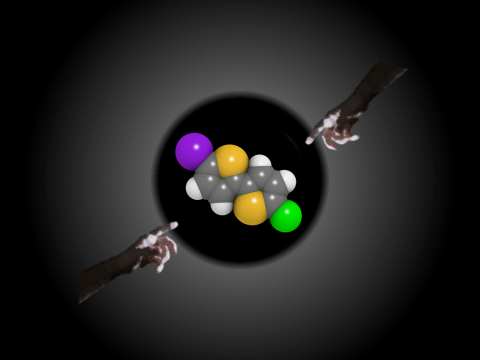Topic Overview
Organic molecules are substances composed of atoms centered on carbon, hydrogen, nitrogen and oxygen. These atoms are so small (<1 nanometer) that it is difficult to control the formation of the molecular structures. Organic molecules randomly collide in the reaction solution, and the recombination of bonds (that is, a chemical reaction) occurs between the colliding molecules. These recombination patterns are, however, completely different depending on the molecular structures and reaction conditions.
Over the past 100 years, organic chemists have accumulated an enormous amount of experience with these recombination patterns and have discovered a variety of empirical guidelines of chemical reactions. For example, organometallic chemistry, which combines organic molecules and metal atoms, was a very powerful tool until the 1990s. The concept of organic catalysts using only organic molecules appeared in the 2000s, and, photoredox chemistry, which uses the transfer of electrons by photo irradiation, has become a new star in the field of reaction development since the 2010s. However, developing new reactions outside of the researchers’ experience is difficult and still requires long-term trial and error guided by the chemists’ intuition.
Development at ICReDD
One of the keys to developing new reactions at ICReDD is the use of computational chemistry. The development of computational chemistry has enabled detailed analysis of reaction mechanisms and the design of new reactions. We have succeeded in the rational development of transition-metal catalysts with precisely controlled structures through computational chemistry and repeated experimental verification1. In addition, we use the AFIR method developed at ICReDD to predict possible reactions by finding all the transition states that are important steps in chemical reactions, and develop new chemical reactions effectively based on the results2. We are also developing mechanochemical and mechanoredox synthesis methods that do not use solvents as a completely new reaction approach3. We believe that, in the future, the efficiency of reaction development can be greatly improved by the incorporation of machine learning.

References
- Iwamoto, H.; Imamoto, T.; Ito, H. Nature Commun. 2018, 9, 2290.
- (a) Mita, T.; Harabuchi, Y.; Maeda, S. Chem. Sci. 2020, 11, 7569. (b) Hayashi, H.; Takano, H.; Katsuyama, H.; Harabuchi, Y.; Maeda, S.; Mita, T. Chem. Eur. J. 2021, 27, 10040.
- (a) Kubota, K.; Seo, T.; Koide, K.; Hasegawa, Y.; Ito, H. Nature Commun. 2019, 10, 111. (b) Kubota, K.; Pang, Y.; Miura, A.; Ito, H. Science 2019, 366, 1500. (c) Takahashi, R.; Hu, A.; Gao, P.; Gao, Y.; Pang, Y.; Seo, T.; Maeda, S.; Jiang, J.; Takaya, H.; Kubota, K.; Ito, H. Nature Commun. 2021, 12, 6691.

